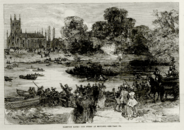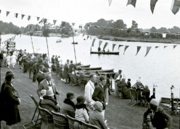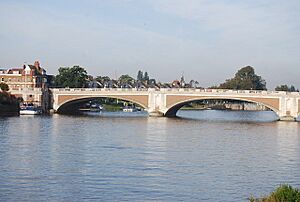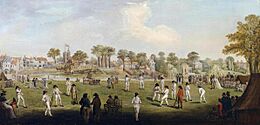Hampton, London facts for kids
Quick facts for kids Hampton |
|
|---|---|
| Suburb | |
 The River Thames at Hampton |
|
| Area | 8.83 km2 (3.41 sq mi) |
| Population | 20,000 |
| • Density | 2,265/km2 (5,870/sq mi) |
| OS grid reference | TQ135705 |
| London borough | |
| Ceremonial county | Greater London |
| Region | |
| Country | England |
| Sovereign state | United Kingdom |
| Post town | HAMPTON |
| Postcode district | TW12 |
| Dialling code | 020 |
| Police | Metropolitan |
| Fire | London |
| Ambulance | London |
| EU Parliament | Greater London |
| UK Parliament |
|
| London Assembly |
|
Hampton is a lively area in Greater London, located on the north side of the River Thames. It's part of the London Borough of Richmond upon Thames and used to be in the historic county of Middlesex. Hampton is surrounded by Bushy Park to the east, the areas of Hampton Hill and Fulwell to the north, green spaces to the west, and the Thames to the south.
Long ago, the area of Hampton included famous places like Hampton Court Palace, Hampton Hill, and Hampton Wick. These are now often called "The Hamptons." Hampton was first settled in Saxon times. After the Norman Conquest in 1066, it was given to a Norman lord. Later, it was owned by the Knights Hospitaller, a group of knights, and then by Henry VIII in 1534.
In the 1800s, common lands were divided up, and London started growing fast. This led to farms becoming market gardens and then plant nurseries. The building of the Hampton Water Treatment Works in the late 1850s and the opening of the railway in 1864 helped Hampton grow. Fields turned into homes, and the population steadily increased. Later, with new ways to transport food, the market gardens closed. In the 1980s, a new housing area called Nurserylands was built.
Today, Hampton is mostly a place where people live. In 2021, its population was around 27,307 people.
Contents
- Hampton's Story: A Look Back in Time
- Hampton and the River Thames: A Special Connection
- Cool Places to See in Hampton
- Sports and Fun Activities in Hampton
- Hampton in Books and Art
- Famous People from Hampton
- Local Services and Transport
- Climate in Hampton
- Nearby Places to Visit
- Images for kids
Hampton's Story: A Look Back in Time
The old parish of Hampton, from Anglo-Saxon times, included what we now know as Hampton, Hampton Hill, Hampton Wick, and the small area around Hampton Court Palace. Together, these are known as The Hamptons. The name Hampton likely comes from old Anglo-Saxon words: hamm, meaning an enclosed space in a river bend, and ton, meaning a farm or settlement.
From ancient times until 1965, Hampton was part of Middlesex. Many local people and businesses still use this old county name.
In the 1920s, Tagg's Island and the riverside area of Hampton became known as the Thames Riviera. This was because of places like the Karsino hotel, which was a big entertainment spot built in 1913. However, the hotel was taken down in 1971. Today, much of Hampton's riverside is private homes, not open parkland.
General Roy's Cannon: A Historic Marker
A cannon in Roy Grove marks a special spot. It's the Hampton end of a long line measured in 1784 by General William Roy. This measurement was part of a big survey to figure out the exact distance between the Greenwich Observatory in London and the Paris Observatory in France. This very accurate survey helped create the first detailed map of Great Britain. The original markers were flagpoles, but later they were replaced by cannons buried in the ground.
Hampton and the River Thames: A Special Connection
Hampton is located on the north bank of a bend in the River Thames. It has always had a strong link with the river. The Thames was important for trade, industry, and fun activities.
River Industries: Boats and More
For centuries, boatyards and slipways have led down to the river from the village. Old boatyards, like Benn's boathouse, were here long ago.
Platt's Eyot, an island in the Thames, was home to many boatyards in the 1800s and 1900s. Thomas Tagg started the first boatyard there in 1866. Later, a German engineer named Moritz Immisch built electric boats there. In 1904, the famous shipbuilder John Isaac Thornycroft opened the Hampton Launch Works. They built cabin cruisers and pleasure boats, including the world water speed record holder, Miss England III.
During wartime, these boatyards changed their focus. In the First World War, they built torpedo boats. In the Second World War, they made motor torpedo boats, motor launches, and landing craft.
Fun on the River: Recreation and Leisure
In the 1800s, more people in London had free time, and trains and trams made it easier to travel. The Thames became a popular place for fun trips. Rowing became very popular, and Hampton Reach hosted many regattas (boat races). Many day-trippers came by river, tram, and train to visit Hampton Court Palace after it opened to the public in 1838. Tagg's Island became a resort with hotels, like the grand Karsino Hotel in 1913.
Islands in the Thames
Hampton has several islands in the River Thames: Platt's Eyot, Benn's Island, and Tagg's Island. Historically, Garrick's Ait and Ash Island were also part of the area.
Platt's Eyot: From Willows to Music Studios
Platt's Eyot is a large island across from the Hampton Water Treatment Works. In the past, willow trees were grown here for making baskets. Later, it became a place for boatyards and small factories. In 1941, a bridge was built to connect the island to the riverbank. Boat building stopped in the 1960s, and the buildings were used for light industry, including music studios. A fire in 2021 destroyed many of the old boatyards.
Benn's Island: A Sailing Hub
Benn's Island is a small, empty island near the Hampton riverbank. In the 1800s, a sailing club used the island. Since 1945, the Hampton Sailing Club has leased it.
Tagg's Island: A Community of Artists
Tagg's Island is a private island where people live in 62 houseboats. It's known for being a community of artists and creative people. In the past, it had hotels and resorts, including the famous Karsino hotel. In 1940, a car company bought the island and used it for making wartime supplies. The hotel was torn down in 1971. In 1980, new owners created a lagoon in the middle of the island and rebuilt a bridge.
River Crossings: Ferries and Bridges
The Hampton Ferry has connected Hampton to the south bank of the Thames since at least 1514. There has also been a ferry linking Hampton Court to East Molesey since Tudor times. The first bridge there was built in 1753. The current Hampton Court Bridge opened in 1933 and is the fourth bridge at that spot.
Managing the River: Locks and Water Flow
Hampton is on the River Thames, between Molesey Lock and Sunbury Lock. The Thames has always been important for moving goods. In the 1800s, large barges pulled by men or horses were common. To make river travel easier, locks were built. Molesey Lock was finished in 1815, and the first lock at Sunbury opened in 1812. These locks help control the river's water level for boats.
Cool Places to See in Hampton
Hampton Water Treatment Works: London's Water Supply
The Hampton Water Treatment Works is a large site that helps clean water for London. It's owned by Thames Water. These works were built in the late 1850s and 1860s because a new law said that drinking water couldn't be taken from the dirty tidal Thames. The original buildings are made of special brick, with big arched windows. In the past, many people worked here. Today, the Waterworks can produce 700 million litres of water a day, supplying about 30% of London's fresh water.
Garrick's Villa and Temple to Shakespeare
Garrick's Villa: An Actor's Home
David Garrick, a famous actor and writer from the 1700s, bought Hampton House in 1754. It was a country house facing the Thames. He made many changes to the house, including adding a grand entrance and a tunnel under the road to his riverside garden. The house became known as Garrick's Villa and is now a protected historic building.
Garrick's Temple to Shakespeare: A Special Shrine
In 1755, Garrick built a special garden building called a "folly" to honor his hero, William Shakespeare. It was designed like the ancient Roman Pantheon, with a dome and columns. Inside, it was a shrine to Shakespeare, filled with Garrick's collection of Shakespearean items. Garrick used it as a quiet place to study and entertain friends. The temple is now a museum and concert venue, open to the public on summer Sunday afternoons.
Hampton Court Palace: A Royal Residence
Cardinal Wolsey started building a royal palace at Hampton Court in 1514. Henry VIII continued and expanded it after Wolsey's time. Hampton Court Palace became a very important place for royal power during the Tudor period. Later, William III made big changes to the palace in the Baroque style, designed by Christopher Wren. Queen Victoria opened the palace to the public in 1838, and it's still a major tourist attraction today. It's managed by a charity called Historic Royal Palaces.
Roy Grove Cannon: Marking a Historic Survey
A cannon in Roy Grove marks the Hampton end of a baseline measured in 1784 by General William Roy. This measurement was part of the Anglo-French Survey (1784–1790), which aimed to precisely locate the Greenwich Observatory and Paris Observatory. This highly accurate survey was the start of the detailed mapping of Great Britain. The original markers were flagpoles, but in 1791, they were replaced by two cannons buried in the ground.
Other Interesting Spots
Rosehill and Hampton Library: A Historic Building
Rosehill is a beautiful 18th-century house on Upper Sunbury Road. It was built for the famous singer John Beard. In 1902, the local council bought it and used it as offices and a library. Since 1937, the whole building has been the Hampton Library. You can see blue plaques on the building honoring John Beard and William Ewart MP, who helped create public libraries.
Old Pubs and Inns: Hampton's History
Hampton has many old pubs and inns, some of which are its oldest buildings and businesses.
- The Feathers: Built around 1540, it was a pub from about 1630 to 1792. Famous people like Samuel Johnson and David Garrick visited it. It's now cottages and is the oldest building still standing in Hampton.
- The Red Lion (originally The Shipp): Built around 1660, it was a popular spot in the late 1800s. It was rebuilt in 1909 after a fire and closed in 1980.
- The Bell Inn: A pub has been on this riverside spot since at least 1557. It was rebuilt in 1892 in a mock-Tudor style after a fire. It's even mentioned in books by Charles Dickens and T.S. Eliot.
- Jolly Coopers: This pub has been at 16 High Street since about 1720 and is Hampton's oldest pub still in its original building.
- The Hamptons Ale House (formerly The Court Jester): This pub opened in 1980 in the new Nurserylands area. After a fire in 2017, it reopened with its new name.
Hampton Youth Project: Fun for Young People
Hampton Youth Project is a youth center in Tangley Park, started in 1990. It's in a converted coach depot and offers many activities for young people aged 11–19.
Beveree Wildlife Site: A Green Oasis
The Beveree Wildlife Site is a special green space north of Station Road. It has mixed woodland, fruit trees, meadows, and orchards, making it important for nature.
Tagg's Island Sundial: A Timepiece in the Park
In the St Albans Riverside park, near the bridge to Tagg's Island, there's a unique sundial. It's a globe with numbered lines and tropic latitudes, resting on three balls on a bell-shaped base.
Hampton Cemetery: A Place of Rest
Hampton Cemetery is a burial ground on Hollybush Lane. It opened in 1879. Many people are buried here, including 14 Commonwealth service members from World War I and seven from World War II.
Sports and Fun Activities in Hampton
Football: Hampton & Richmond Borough F.C.
Hampton & Richmond Borough F.C. is a semi-professional football club. They play at Beveree Stadium, which can hold 3,500 fans, and have been there since 1959.
Rugby: Twickenham Rugby Football Club
Twickenham Rugby Football Club started in 1867. They moved to their current home ground west of Hampton in 1930.
Cricket: A Long Tradition
Hampton's first cricket club, the Royal Clarence Cricket Club, began in 1828. They played their matches at what is now Hurst Park. Hampton Hill Cricket Club started in 1855 and moved to its current ground in Bushy Park in 1890. They also play at Carlisle Park in Hampton.
Sailing: On the Wide Thames

The River Thames is wide at Hampton Reach, and the wind makes it a great place for sailing. The Benn's Island has been used by the Hampton Sailing Club since 1945. They have a clubhouse and boatyard, and their races run from upstream of Platt's Eyot down to Tagg's Island.
Rowing: Regattas and Races
A Watermen's Regatta was first held in Hampton in 1835 and continued until 1910. It even included fun activities like water jousting.
Molesey Boat Club has run the Molesey Regatta since 1867. In the past, the races finished near Garrick's Temple, with crowds watching from Garrick's Lawn. Today, the race course is 850 meters long, starting upstream of Platt's Eyot.
The rowing clubs of Hampton School and Lady Eleanor Holles School share the Millennium Boathouse. Both clubs have trained many British champions and international rowers.
Canoeing: On the River
Hampton Canoe Club, originally called Westel Club, started in 1970. Since 1990, it has been based at the old pumping station at Bell Hill.
Triathlon: Swim, Bike, Run
Thames Turbo Triathlon Club started in 2012 and is based at Hampton Pool. They hold an annual triathlon in May, with swimming at Hampton Pool, cycling along Hampton Court Road, and running in Bushy Park. They also have a junior aquathlon (swim and run) in June.
Hampton Pool: An Outdoor Swimming Spot
Hampton Heated Open Air Pool and Gym near Bushy Park was built in 1922. A diving area and filter system were added in 1939, and the pool was made wider in 1961. The council closed the pool in 1980 due to money problems, but it reopened in 1985 with community support and is now run by a charity.
Hampton in Books and Art
Art: Impressionist Paintings
Alfred Sisley and Camille Pissarro: Painting Hampton
During the Franco-Prussian War, some Impressionist artists came to England. The Anglo-French painter Alfred Sisley visited Hampton Court in 1874 and painted many scenes along the River Thames around Hampton Court and Molesey. His painting Regatta at Molesey near Hampton Court shows the Molesey Regatta with the Island Hotel on Tagg's Island in the background. The Thames with Hampton Church shows the view towards Hampton, including St Mary's Church and Garrick's Temple to Shakespeare.
French Impressionist painter Camille Pissarro also visited London. In 1890, he painted six London scenes, including Hampton Court Green, which shows a cricket match.
Literature: Hampton in Famous Novels
Anthony Trollope
The 1857 novel The Three Clerks by Anthony Trollope is set in Hampton, when it was a village outside London.
Charles Dickens
Hampton appears in two Charles Dickens novels. In Oliver Twist, Oliver and Bill Sikes stop at a pub in Hampton on their way to a planned burglary. In Nicholas Nickleby, characters visit the 'Hampton Races', which refers to a racecourse at 'Moulsey Hurst'.
H.G. Wells
H.G. Wells wrote The War of the Worlds while living nearby. He mentions Hampton Court in his book.
T.S. Eliot
In 1936, T.S. Eliot, a famous poet, stayed at the Bell Inn in Hampton. His time there led to a reference in his book Old Possum's Book of Practical Cats.
Jerome K. Jerome
Hampton is also mentioned in the funny book Three Men in a Boat by Jerome K. Jerome.
Other Media: TV Shows
The street on Station Road, Hampton, near the old Police Station, has been used as a background for TV series like Fleabag and The Gold.
Famous People from Hampton
People Living Today
- Evgeny Lebedev: Owner of Stud House.
- Hayley Mills (born 1946): Actress, lived in Hampton with her son Crispian Mills (born 1973), a singer and film director.
- Bill Milner (born 1995): Actor, lives in Hampton.
- Brian May (born 1947): Musician and astrophysicist, born in Hampton.
Historical Figures

- Queen Anne: Lived at Hampton Court Palace.
- John Beard (c.1717–1791): Singer, lived at what is now Hampton Library.
- Julian Bream (1933–2020): Musician, grew up in Hampton.
- Lancelot "Capability" Brown (1716–1783): Famous landscape designer, lived at Wilderness House, Hampton Court Palace.
- Charles I: Was held prisoner at Hampton Court in 1647.
- Charles II: Lived at Hampton Court in 1665 to avoid the plague.
- Sir Richard Doll (1912–2005): A scientist who studied diseases, was born in Hampton.
- William Ewart (1798–1791): Politician who promoted public libraries, lived at Hampton Library.
- David Garrick (1717–1779): Actor, lived at Garrick's Villa, Hampton.
- George I: Ordered the completion of rooms at Hampton Court Palace.
- Henry VIII: Married his sixth wife, Catherine Parr, at Hampton Court Palace.
- Norman Cyril Jackson VC (1919–1994): A war hero, died in Hampton Hill.
- Edward Lapidge (1779–1860): Designed the current Kingston Bridge, was born in Hampton Wick.
- Mary I: Spent her honeymoon at Hampton Court.
- Jane Seymour: Henry VIII's third wife, gave birth to Edward VI of England at Hampton Court Palace.
- Alan Turing (1912–1954): A famous code breaker, lived in Hampton High Street from 1945 to 1947.
- William, Duke of Gloucester: Son of Queen Anne, was born at Hampton Court in 1689.
- William III and Mary II: Rebuilt parts of Hampton Court Palace.
- Thomas Wolsey (1473–1530): A powerful Cardinal, lived at Hampton Court.
- Sir Christopher Wren (1632–1723): Famous architect, lived at The Old Court House, Hampton Court Green.
- Xenia Alexandrovna of Russia: Sister of Tsar Nicholas II, lived in the grounds of Hampton Court Palace from 1937 until her death in 1960.
Local Services and Transport
Education: Schools in Hampton
Hampton has many schools for children of all ages.
Secondary Schools
- Hampton High: A school for both boys and girls.
- Turing House School: A school for both boys and girls.
- Hampton School: An independent school for boys.
- Lady Eleanor Holles School: An independent school for girls.
- Hampton Court House: An independent school for both boys and girls.
Primary and Infants Schools
- Hampton Junior School
- Hampton Infant School and Nursery
- Hampton Hill Junior School
- Carlisle Infants School
- Buckingham Primary School
- Hampton Prep School (formerly Denmead): The junior school for Hampton School.
- Twickenham Prep School
- Jack & Jill School (including Nightingale House and Clarence House)
- St Mary's Hampton CE Primary School
Churches: Places of Worship
Church buildings are important in Hampton. St Mary's Church and St James's Church are notable historic buildings.
Local churches include:
- Hampton Methodist Church, Hampton
- Hampton Hill United Reformed Church, Hampton Hill
- St Theodore's Roman Catholic Church, Hampton
- St Francis de Sales, Hampton Hill and Upper Teddington (Roman Catholic)
- All Saints (Church of England), Old Farm Road, Hampton
- St Mary (Church of England), Church Street (by Thames Street) Hampton
- St James' Church, Hampton Hill (Church of England)
The Christian churches in Hampton and Hampton Hill work together.
Transport: Getting Around Hampton
- Roads
Hampton does not have tall buildings or big dual carriageways. Its main roads, the A308 and A312, have extra lanes for buses or turning in busy areas.
Bus routes serving Hampton include the 111, 216, R68, and R70. Other routes serve Hampton Court and Hampton Hill.
- Rail
Hampton railway station is near the shops in the southwest. Just north of Hampton Hill is Fulwell railway station. Both are on the Shepperton Branch Line. Near Hampton Court Palace is Hampton Court railway station on the Hampton Court branch line. Hampton Wick railway station is on the Kingston loop line. All these lines go to London Waterloo in central London.
Climate in Hampton
| Climate data for Hampton Water Works - Climate Station (1991–2020) | |||||||||||||
|---|---|---|---|---|---|---|---|---|---|---|---|---|---|
| Month | Jan | Feb | Mar | Apr | May | Jun | Jul | Aug | Sep | Oct | Nov | Dec | Year |
| Mean daily maximum °C (°F) | 8.5 (47.3) |
8.9 (48.0) |
11.5 (52.7) |
14.7 (58.5) |
18.0 (64.4) |
20.9 (69.6) |
23.2 (73.8) |
22.8 (73.0) |
19.8 (67.6) |
15.7 (60.3) |
11.6 (52.9) |
8.9 (48.0) |
15.4 (59.7) |
| Mean daily minimum °C (°F) | 2.9 (37.2) |
2.8 (37.0) |
4.1 (39.4) |
6.0 (42.8) |
9.0 (48.2) |
12.0 (53.6) |
14.1 (57.4) |
14.0 (57.2) |
11.5 (52.7) |
8.8 (47.8) |
5.6 (42.1) |
3.3 (37.9) |
7.9 (46.2) |
| Average rainfall mm (inches) | 57.5 (2.26) |
44.1 (1.74) |
37.5 (1.48) |
40.6 (1.60) |
42.1 (1.66) |
48.9 (1.93) |
43.3 (1.70) |
55.5 (2.19) |
49.9 (1.96) |
65.8 (2.59) |
66.0 (2.60) |
57.2 (2.25) |
608.5 (23.96) |
| Average rainy days (≥ 1 mm) | 11.2 | 9.6 | 8.4 | 8.4 | 7.8 | 8.3 | 7.3 | 8.5 | 8.0 | 10.4 | 11.0 | 10.6 | 109.5 |
| Mean monthly sunshine hours | 56.8 | 78.0 | 120.4 | 168.0 | 202.9 | 203.2 | 212.8 | 196.4 | 153.5 | 111.8 | 64.2 | 50.8 | 1,618.9 |
| Source: Met Office | |||||||||||||
Nearby Places to Visit
- Twickenham
- Sunbury
- Fulwell
- Hanworth
- Teddington
- Whitton
- West Molesey
- East Molesey
- Esher
- Hampton Wick
- Kingston
Images for kids
-
The River Thames at Hampton































